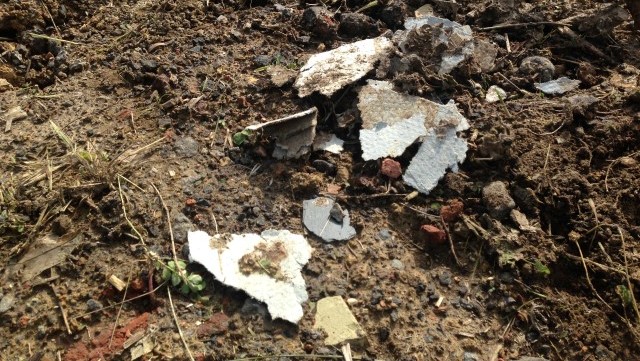The risk of asbestos on brownfield sites
Contents |
[edit] Introduction
‘Brownfield’ sites are at higher than normal risk of asbestos contamination, by their very nature. As a brownfield site is defined as a building site which has previously been developed, there is a chance that the building/s that previously occupied the space may have contained asbestos.
Although there are strict controls on the removal of asbestos from buildings earmarked for demolition or redevelopment, they are not always followed. If a site has been left undeveloped for a reasonable period of time, there is also a risk that it might have been used for illegal disposal of material (flytipping), or that the previous building might have been demolished prior to the establishment of the Control of Asbestos Regulations.
Discovering that a site has been contaminated once development begins can be costly, problematic and dangerous - it will also almost certainly delay the project, and can stop it entirely.
[edit] What is asbestos?
Asbestos is a naturally occurring mineral, commonly known as either white, blue or brown asbestos. It was used extensively during the industrial revolution and the years following it, but it’s usage had almost ceased completely in most countries by the 1990’s. Where it was still used, it was so heavily regulated that most trades avoided it entirely.
For more information see: Asbestos.
[edit] Health risks associated with asbestos
Due to its fibrous nature, asbestos can be introduced to the respiratory system through inhalation. Once it reaches the lungs, it has been found to be responsible for a host of serious and often fatal diseases which include mesothelioma, lung cancer and asbestosis. Mesothelioma is a type of cancer that develops in the lining of some of the body's organs and is mostly linked to asbestos exposure. There is currently no cure for mesothelioma.
[edit] How do brownfield sites become contaminated with asbestos?
Although the HSE (Health and Safety Executive) have published strict guidelines for the removal of asbestos, historically this was not the case. Even when the guidelines are adhered to, there is always the risk that asbestos is missed prior to building demolition, or improperly disposed of. Buildings demolished prior to the establishment of the Control of Asbestos Regulations are at particularly high risk of contaminating the ground around them.
If a building is demolished while asbestos is present, the asbestos materials may contaminate the ground. While it is undisturbed, the risk to the general public and those working on the site is low. However, once the ground is broken during construction, the fibres will become airborne and at this stage it becomes likely that anyone working on or around the site might be exposed to the asbestos fibres.
[edit] Risks associated with developing brownfield sites
There are multiple challenges associated with developing brownfield sites, and it is critical that a full risk assessment is undertaken prior to work proceeding for this reason.
[edit] Financial risk
If asbestos is discovered after work on a site commences, it is inevitable that work will have to cease until the contamination is assessed and remediated. As well as the increased financial burden of late testing taking place, it is possible that the delays incurred will cause an increase in costs associated with wages, site overheads and potential penalties.
[edit] Health risks
As there is currently no safe exposure level for asbestos, anyone working or living around the site could be at risk from exposure. This in turn could lead to future litigation should anyone actually develop an illness linked to asbestos exposure.
[edit] Legal and regulatory risks
The discovery of asbestos on site following the commencement of construction could lead to RIDDOR reports, the involvement of the HSE, and even prosecution and fines.
[edit] Reputational damage
Since 2008, the HSE has had the power to make Publicity Orders against any business or corporation found guilty of breaching Health and Safety Law. This means that the organisation in question will be required to take out an advertisement in either their trade or the national press, detailing the offence that they have been found guilty of, the fine and/or sentence that was imposed upon them following prosecution and the terms of any remedial order made against them. Some commentators believe that businesses that have been forced to comply with one of these orders have a much greater risk of failure within the first year of the Publicity Order being made, so great is the reputational damage incurred.
[edit] Legal cases
The most accurate figures for claims arising from ill health suggest payouts exceeded £17.5 billion between 1998 and 2010.
The consequences of asbestos related illnesses are so serious that trusts have been formed to ensure that those who suffer from these chronic health conditions are able to access the funds. People with asbestos related illnesses are likely to require funding for adaptations to their homes, increased expenditure on health expenses and the additional burden placed on their families by their incapacitation and eventual death.
[edit] Related articles on Designing Buildings Wiki
- Asbestos.
- Asbestos cement.
- Asbestos register.
- Brownfield site.
- CDM.
- Conceptual site model.
- Contaminated land.
- Failure to mention asbestos.
- Five signs you are at risk of asbestos poisoning at work.
- Ground investigation.
- Hazardous substances.
- Pre-construction information.
- Risk assessment.
- Site appraisal.
- Site information.
- Site survey.
- Solid and liquid contaminants risk assessments.
[edit] External references
- The Challenging Risks of Asbestos in Brownfield Sites (Alec Hales Contaminated Land Specialist).
- https://www.pbctoday.co.uk/news/health-safety-news/asbestos-brownfield-sites/20370.
- https://sobra.org.uk/.
- http://www.hse.gov.uk/asbestos/managing/brownfield.htm.
- Fibrosis of the Lungs Due to Inhalation of Asbestos Dust (W.E Cooke).
- https://www.ncbi.nlm.nih.gov/pmc/articles/PMC2304688/.
- http://www.hse.gov.uk/pubns/indg417.pdf.
- http://www.sandwell.gov.uk/info/200274/pollution/483/asbestos_removal.
Featured articles and news
Latest Build UK Building Safety Regime explainer published
Key elements in one short, now updated document.
UKGBC launch the UK Climate Resilience Roadmap
First guidance of its kind on direct climate impacts for the built environment and how it can adapt.
CLC Health, Safety and Wellbeing Strategy 2025
Launched by the Minister for Industry to look at fatalities on site, improving mental health and other issues.
One of the most impressive Victorian architects. Book review.
Common Assessment Standard now with building safety
New CAS update now includes mandatory building safety questions.
RTPI leader to become new CIOB Chief Executive Officer
Dr Victoria Hills MRTPI, FICE to take over after Caroline Gumble’s departure.
Social and affordable housing, a long term plan for delivery
The “Delivering a Decade of Renewal for Social and Affordable Housing” strategy sets out future path.
A change to adoptive architecture
Effects of global weather warming on architectural detailing, material choice and human interaction.
The proposed publicly owned and backed subsidiary of Homes England, to facilitate new homes.
How big is the problem and what can we do to mitigate the effects?
Overheating guidance and tools for building designers
A number of cool guides to help with the heat.
The UK's Modern Industrial Strategy: A 10 year plan
Previous consultation criticism, current key elements and general support with some persisting reservations.
Building Safety Regulator reforms
New roles, new staff and a new fast track service pave the way for a single construction regulator.
Architectural Technologist CPDs and Communications
CIAT CPD… and how you can do it!
Cooling centres and cool spaces
Managing extreme heat in cities by directing the public to places for heat stress relief and water sources.
Winter gardens: A brief history and warm variations
Extending the season with glass in different forms and terms.
Restoring Great Yarmouth's Winter Gardens
Transforming one of the least sustainable constructions imaginable.
























